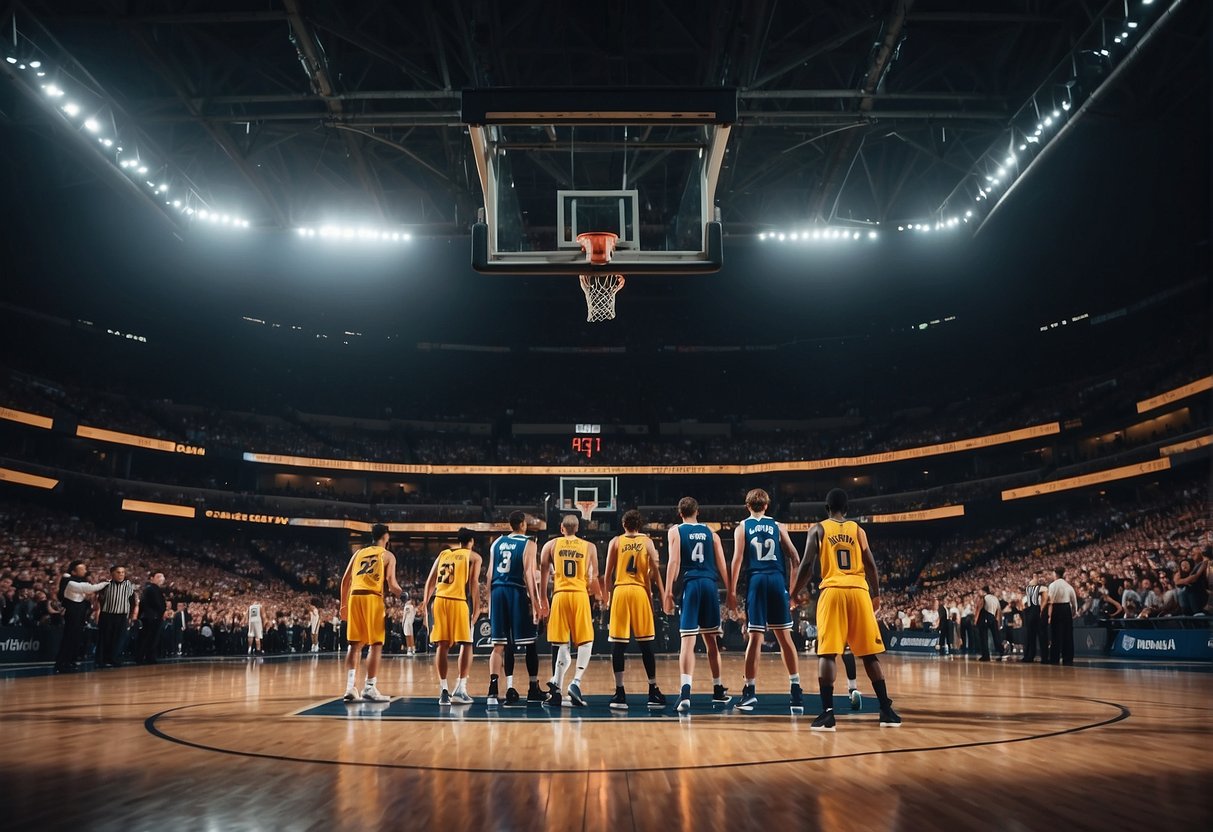Unlock the dynamics of basketball scoring with my expert knowledge: what is basketball bonus? Explore the strategic implications of reaching the bonus in basketball games.
What is Basketball Bonus?
When you’re watching a basketball game, you might hear the term “bonus” thrown around, especially as the game heats up. The bonus situation in basketball is a rule designed to prevent excessive fouling by penalizing teams for committing a certain number of fouls.
In the NBA, once a team commits its fifth defensive or loose ball foul during a quarter, the opposing team is rewarded with what is known as the bonus. From this point, the team in the bonus will get free throws for any subsequent non-shooting defensive foul. The format used is often two free throws, ensuring a chance to score no matter the outcome of the first shot.
Meanwhile, under NCAA rules, the bonus is a bit more complex at the collegiate level. The team enters the one-and-one situation on the seventh team foul. The player gets to shoot one free throw, and only if they make it do they get to try a second. After the tenth team foul, the team is awarded the double bonus, which guarantees two free throw attempts.
Internationally, FIBA rules differ slightly but are closer to NBA regulations, with two free throws being awarded after the fifth foul in a period. The essence of the rule across all associations is to maintain fairness and to discourage teams from continually stopping play through fouling.
The Bonus Rules Across Different Leagues

NBA Bonus Rules
In the NBA, the bonus rule triggers when a team commits 5 fouls within a quarter. Upon reaching the limit, the opposing team is granted two free throws. This rule keeps the game fair by penalizing excessive fouling. For those last critical two minutes of any quarter, any foul committed by the defense results in automatic free throws, bringing a strategic twist to the endgame.
NCAA Basketball Bonus Rules
The NCAA splits bonus rules into single bonus and double bonus. Your team enters the single bonus after the opposing team racks up 7 team fouls in half, allowing for one-and-one free throws. This means if you make the first shot, you get a second. Once the opposing team reaches 10 fouls, you’re in the double bonus, and every foul brings two free throws, regardless if the first shot is made.
FIBA Bonus Rules
FIBA regulations state that the bonus rule kicks in on the fifth team foul in each period or the second team foul in the last two minutes if the previous foul limit wasn’t reached. Similar to the NBA, this also awards two free throws. The bonus situation in FIBA games ensures teams play aggressively but cautiously.
High School Bonus Rule
High school basketball, governed by the NFHS, follows similar bonus rules to the NCAA. The team enters the bonus after seven fouls in a half. Here, your team is granted a one-on-one opportunity. After the opposing team’s 10th team foul in a half, you receive two free throws for each subsequent non-shooting foul, often increasing scoring chances late in the game.
Team Fouls and Bonus Situations

In basketball, navigating team fouls is crucial. Your team enters a penalty situation, or “bonus,” when it reaches a certain threshold of fouls, granting the opposing team free throws on subsequent non-shooting fouls.
Team A and Team B Foul Dynamics
When Team A accumulates a specific number of fouls, it triggers the bonus, empowering Team B to receive free throw opportunities more easily. For example, in the NBA, Team A enters the penalty after committing its fifth foul in a quarter. If you’re part of Team A, each of your fouls beyond this limit will enable any fouled opponent from Team B to shoot free throws, altering the strategic approach of the game.
Conversely, if you are on Team B and Team A is in the bonus, your team can capitalize on this by drawing fouls, pushing for opportunities to score from the free-throw line. The dynamic between both teams becomes a strategic chess match, where managing fouls and understanding the bonus rule can swing momentum and potentially the game in your favor.
Resetting Team Fouls
Your team’s foul count is reset to zero at the start of each quarter (or half, depending on the league). This provides a clean slate and a chance to adjust tactics without the immediate pressure of the bonus.
In international play, for instance, the foul count is reset at halftime rather than each quarter. You must navigate the entire half strategically to avoid putting the opposing team in the bonus too early.
Types of Fouls and Free Throws

Shooting vs. Non-Shooting Fouls
Shooting fouls occur when a defender contacts a player in the act of shooting. You’re awarded free throw attempts if you’re fouled while making a shot attempt. The number of free throws depends on where the shot was taken; usually, one free throw for a successful basket or two to three for an unsuccessful attempt beyond the three-point line.
On the other hand, non-shooting fouls involve illegal contact when the ball is in play but the player is not attempting to score. In these cases, unless the team is in a bonus situation, the fouled team takes the ball out of bounds.
Personal and Technical Fouls
Personal fouls involve physical contact between players. As a player, they accumulate against you, and getting too many can lead to your disqualification from the game.
Technical fouls refer to violations of game conduct, such as unsportsmanlike behavior or illegal game management. The opposing team takes free throws awarded from technical fouls, and they also retain possession of the ball. Unlike personal fouls, they do not contribute to the team foul count, leading to the bonus situation.
Game Scenarios Involving the Bonus

Late-Game Strategies
In the final minutes of a game, if you’re trailing and in a bonus situation, strategically fouling can stop the clock and give your team a chance to score without running out. Conversely, if you’re ahead, protecting the lead involves avoiding unnecessary fouls and managing your fouls to give.
Your team can commit these fouls without putting the opposing team in the bonus, thus preventing them from scoring easy points from the free-throw line.
In contrast, drawing defensive fouls can be to your advantage when you have possession. Even when not in the act of shooting, being in the bonus means any foul by the opposition results in free throws, offering a chance to score with the clock stopped.
Overtime and Bonus Interaction
The interplay between overtime periods and bonus situations introduces a fresh dynamic. Each overtime period starts with a clean slate regarding team fouls. However, because overtime periods are shorter, teams reach the bonus quicker, usually after four team fouls. This amplifies the importance of each foul committed.
Knowing the opposing team’s foul count and whether they still have fouls to give can inform your offensive approach. Drawing fouls early in the overtime can put you in a bonus situation faster, giving you a potential scoring edge as the game clock winds down.
While offensive fouls do not count towards the bonus, being mindful of the timing and type of fouls you commit is critical. These fouls can give possession to the opposing player, which is especially risky if your team is already over the limit and in the bonus.
Common Questions About Basketball Bonus

When navigating basketball rules, you may often hear about the “bonus” and “double bonus” situations. These crucial aspects of the game dictate when and how free throws are awarded following fouls. Understanding the bonus rules can enhance your appreciation for the strategy and fairness in the sport.
FAQ on Bonus Rules
- What exactly is the “bonus” in basketball?
- When a team accumulates a certain number of fouls within a game period, the opposing team can shoot free throws on non-shooting fouls. This is known as entering the “bonus”.
- How many fouls are needed for the bonus and double bonus?
- A team enters the bonus after the opposing team commits the fifth team foul in the NBA and FIBA, and the seventh team foul in NCAA college basketball. The double bonus is awarded in college basketball after the tenth foul.
- Does the NBA have a double bonus?
- No, the NBA does not have a double bonus rule. Instead, beginning with the fifth team foul or the last two minutes of a quarter, if in the penalty, all non-shooting fouls result in two free throws.
Impact of Rule Changes
- How have bonus rules changed over time?
- The rules around basketball bonus have evolved to discourage intentional fouling. For example, the hack-a-Shaq strategy, fouling a poor free-throw shooter intentionally, has led to adjustments in how fouls are administered in the bonus.
- What are the implications for fair play?
- The bonus rule promotes fair play by penalizing teams for excessive fouling, encouraging more skillful defense. The bonus cap ensures that games flow more smoothly without being bogged down by continuous stoppages for fouls.
FAQ
What is the bonus thing in NBA?
In the NBA, the “bonus” refers to a team accumulating a certain number of team fouls within a specified period, usually a quarter. Once a team reaches a certain threshold of fouls (commonly five team fouls), the opposing team is awarded bonus free throw opportunities for every subsequent foul committed by the defensive team during that period.
What is the big bonus in overtime basketball?
No specific term is known as the “big bonus” in overtime basketball. However, teams may continue accumulating team fouls in overtime periods, resulting in bonus free throw opportunities for the opposing team after a certain threshold of fouls is reached, similar to regulation play.
What is bonus plus in NCAA basketball?
In NCAA basketball, teams enter the “bonus” situation when the opposing team commits several team fouls within a specified period, typically a half. Once the bonus (usually seven team fouls) is reached, the fouled team is awarded one-and-one free throw opportunities. Suppose the fouled team reaches a higher threshold of team fouls (usually ten). In that case, the opposing team is awarded two free throws for every subsequent foul committed during that period, commonly called a “double bonus” or “bonus plus.”
If you enjoyed reading about the topic: What is Basketball Bonus, leave a comment and stay updated on Pinterest for more exciting basketball news.
Leave me a comment and make sure to also check out NBA Shot Chart.






